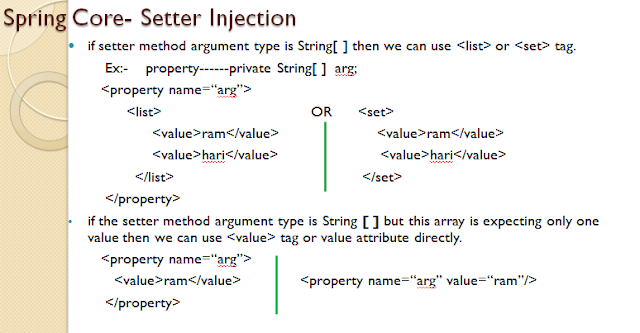 The most fundamental feature of the Spring Framework
is IOC and Dependency Injection. Container
resolves dependent components by setting implementation Object instead of Component Instantiation.Most of
the code in Spring is reduced using Dependency Injection and some part
of the code (Exception logic ,Transaction Logic )required in Service and DAO
classes is reduced using AOP(Aspect
Oriented Programming).Even AOP can simplify Security and Logging Logic
etc..
The most fundamental feature of the Spring Framework
is IOC and Dependency Injection. Container
resolves dependent components by setting implementation Object instead of Component Instantiation.Most of
the code in Spring is reduced using Dependency Injection and some part
of the code (Exception logic ,Transaction Logic )required in Service and DAO
classes is reduced using AOP(Aspect
Oriented Programming).Even AOP can simplify Security and Logging Logic
etc..
Spring does not provide its own ORM but we can
integrate spring with any existing ORM’s. Generally ORM can simplify Persistence
logic (JDBC Code) if we are integrating ORM with Spring we can get all features
that are provided by Spring(Dependency Injection, Exception Logic, Txn Logic
,Security ,Logging etc..)
Spring provides its own MVC and it is completely based
on Dependency Injection
Spring can also be integrated with J2EE Technologies
such as EJB,RMI,JMS etc… .
org.springframework.beans.factory.BeanFactory is the actual representation of the Spring IOC container
that is responsible for containing and otherwise managing the configured beans.
BeanFactory Provides implementation of FactroryPattern which removes the need of programmatic
singleton.
Instantiating
a Spring IoC container :
Resource resource = new FileSystemResource(“Spring-config.xml");BeanFactory factory = new XmlBeanFactory(resource);(OR)ClassPathResource resource = new ClassPathResource(“spring-config.xml");BeanFactory factory = new XmlBeanFactory(resource);
The most commonly used BeanFactory implementation
is the XmlBeanFactory class. In terms of
XML The XmlBeanFactory takes this XML configuration meta data and uses it to create a
fully configured system or application. BeanFactory reads spring-config.xml file and checks if
singleton is true or false for configured beans (default is true) if it is true
it will create the object once and kept that object In static HashMap and
whenever the object is required return the object from Hashmap , if it is false
create the object every time and return that
object directly .After Reading config file Container create
objects using Reflection API and while
creating to the constructor it will pass argument values using java.lang.reflect.Constructor
then once the object is created container will call the setter methods using that
object
The ApplicationContext interface builds on top of the BeanFactory
(it is a sub-interface) and adds other functionality such as easier integration
with Spring's AOP features, message resource handling (for use in
internationalization), event propagation, and application-layer specific
contexts such as the WebApplicationContext for use in web applications.
package
com.springcore;
public
class Person
{
private
String personID;
private
String name;
Person(String id)
{
this.personID=id;
}
public void
setName(String name)
//-------------setter method for Name
{
this.name=name;
}
public
String getName()
{
return
name;
}
// Here
Setter and Getter for personID field
public
void message() //------we
are calling this method using spring given object.
{
s.o.p(“Welcome “+name);
} |
} // Here value for the name field is configured
in xml file so spring can inject this value to the property while creating the object
spring-config.xml:--
<beans>
<bean id=“person” class=“com.springcore.Person”>
<constructor-arg index=“0” type=“java.lang.String”>
<value>Trigyn171</value>
</constructor-arg>
<property
name=“name”>
<value>Rammohan</value>
</property>
</bean>
</beans>
Test class :-
Class Test
{
public
static void main(String[ ] args)
{
//Activating
Spring Container
BeanFactory factory=new XmlBeanFactory(“spring-config.xml”);
//creating
and getting the bean object
Person
person=(Person)factory.getBean(“person”);
|
|…….//bean id
|….//Spring
creates the object and given to the user
person.message();
}
}
- If the setter method arg type is List we can use <list> tag inside <property> tag
- If the setter method arg type is Set then we can use <set> tag inside <property> tag
- If the setter method argument type is Map then we can use <map> and <entry>combination inside <property> tag
Ex:-
<property
name=“argument”>
<map>
<entry key=“id”
value=“1”/>
<entry
key=“name” value=“ram”/>
</map>
</property>
If the setter method argument
type is Properties then we can use
<prop> tag inside props>
tag
//private Properties
p;
<property name=“p” >
<props>
<prop
key=“name”>
<value>Ram</value>
</prop>
<prop key=“marks”
value=“100”>
</props>
</properties>


Thanks Rammohan ,its really useful and helpful for me.
ReplyDeletePlease provide some information about spring annotation.
Thanks for your suggestion,
DeleteMy self i need to upgrade the latest things of spring.
sure you will get annotation stuff very soon.